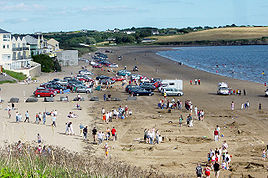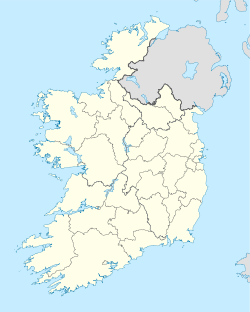- Duncannon
-
This article is about the place in Ireland. For the city in the United States, see Duncannon, Pennsylvania.
Duncannon
Dún Canann— Town — Location in Ireland Coordinates: 52°13′16″N 6°55′55″W / 52.221°N 6.932°WCoordinates: 52°13′16″N 6°55′55″W / 52.221°N 6.932°W Country Ireland Province Leinster County County Wexford Elevation 48 m (157 ft) Population (2006) - Urban 291 Time zone WET (UTC+0) - Summer (DST) IST (WEST) (UTC-1) Irish Grid Reference S722093  A sandcastle building contest taking place on the sandy Duncannon Blue Flag beach
A sandcastle building contest taking place on the sandy Duncannon Blue Flag beach
 Lighthouse located north of Duncannon near Arthurstown, Ballyhack, An Pasaiste, Passage and Passage East, County Wexford
Lighthouse located north of Duncannon near Arthurstown, Ballyhack, An Pasaiste, Passage and Passage East, County Wexford
Duncannon (Irish: Dún Canann, meaning "the Fort of Conán, possibly Conán mac Morna of the Fianna") is a village in southwest County Wexford, Ireland. Bordered to the west by Waterford harbour and sitting on a rocky promontory jutting into the channel is the strategically prominent Duncannon Fort which dominates the village.
Primarily a fishing village, Duncannon also relies heavily on tourism and is situated on the clearly signposted and very scenic Ring of Hook drive. Duncannon boasts a mile long, blue flag recipient golden beach and is a very popular spot with locals and tourists alike.[citation needed]
Duncannon Fort, which was built in 1588 incorporates a maritime museum, Arts centre, café and craft shop and is open daily to visitors from June to September. Guided tours are available. Duncannon and Fort was the location for the opening scenes of the 2002 remake of 'The Count of Monte Cristo', starring Jim Caviezel and Richard Harris[1].
Contents
History
According to legend, the settlement at Duncannon dates back to the time of Fionn mac Cumhaill (pop: Finn McCool) and the Fianna in the 3rd century AD.[citation needed]
Duncannon was of vital strategic importance as its fort commanded the bay giving sea access to Waterford Harbour. As a result it was centrally involved in wars and sieges during the 17th and 18th centuries.
During the Irish Confederate Wars (1641-1652), the fort at Duncannon was initially occupied by English soldiers and used as a base for an attack on nearby Redmond's Hall (now Loftus Hall). During this period it was besieged three times. In 1645 it was taken by an Irish Confederate army under general Thomas Preston. Its English garrison surrendered after lengthy bombardment, during which their commander was killed and a ship trying to bring supplies to the garrison was sunk (see Siege of Duncannon). During the Cromwellian conquest of Ireland, Duncannon was besieged again,[2] as part of the Siege of Waterford, firstly in November 1649 by Oliver Cromwell and Michael Jones in 1649. The fort's Irish garrison held out and the siege was abandoned in December of that year. However in July 1650 Henry Ireton renewed the siege and the fort and town surrendered after the fall of Waterford, but before their food and supplies had run out.[citation needed]
In the Williamite war in Ireland (1689-91) James II, after his defeat at the battle of the Boyne, embarked at Duncannon for Kinsale and then to exile in France. Later his son in law and enemy William of Orange, marched on its cobblestones as the town and fort surrendered to his army without resistance.[citation needed]
The fort at Duncannon was one of the few places in county Wexford that did not fall to the rebels during the 1798 rebellion though a force sent out from the fort to defend Wexford town was defeated at the battle of Three Rocks. The fort and town then became a sanctuary for fleeing loyalists and troops in south Wexford and was also used as a prison and place of execution for suspected rebels.[citation needed]
Duncannon's strategic importance continued to be recognised throughout the 19th century. Napoleon sought and got intelligence on its strength and weakness, in preparation for a possible invasion of Ireland.[citation needed]
Duncannon fort was used by the FCA (Irish army reserve) as a barracks and training facility until recent years.[citation needed]
See also
References
- ^ "Count of Monte Cristo comes to Duncannon". Wexford People. August 28, 2000. http://www.wexfordpeople.ie/premium/news/count-of-monte-cristo-comes-to-duncannon-992630.html.
- ^ McKeiver[page needed]
- Philip McKeiver, "A New History of Cromwell's Irish Campaign", Advance Press, Manchester 2007, ISBN 978-0-9554663-0-4
External links
Irish lighthouses Lighthouses are shown in anti-clockwise sequence beginning from the north and proceeding west, south, east, and back to north. County Donegal Inishowen · Inishtrahull · Fanad · Dunree · Buncrana · Tory Island · Arranmore · Ballagh Rocks · Rathlin O'Birne · Rotten Island · St. John's

County Sligo Blackrock · Lower Rosses Point · Metal Man · Oyster Island
County Mayo Broadhaven · Eagle Island · Blackrock · Blacksod Bay · Achillbeg · Inishgort
County Galway Slyne Head Cashla Bay · Eeragh · Straw Island · Inisheer
County Clare Blackhead · Loop Head · Kilcredaun Head · Corlis Point Front · Corlis Point Rear · Scattery Island
County Kerry Little Samphire Island · Inishtearaght · Cromwell Point · Valentia Rear · Valentia Front · Skelligs
County Cork Bull Rock · Ardnakinna · Castletown Directional Light · Roancarrig · Sheep's Head · Mizen Head · Crookhaven · Copper Point · Fastnet Rock · Baltimore Beacon · Galley Head · Old Head of Kinsale · Charlesfort · Roches Point · Ballycotton · Youghal
County Waterford Mine Head · Ballinacourty Point · Dunmore East
County Wexford Duncannon · Hook Head · Tuskar Rock
County Wicklow County Dublin Muglins · Poolbeg · Kish Bank · Baily · Howth Head · Rockabill
County Louth County Down Green Island · Vidal Bank · Haulbowline · St. John's Point · ` Angus Rock · Donaghadee · Mew Island
County Antrim Blackhead · Chaine Tower · The Maidens · Rathlin East · Rue Point · Rathlin West
List of lighthouses in Ireland · Lightvessels in Ireland · Commissioners of Irish Lights · Category:Lighthouses in Ireland · List of islands of Ireland · Coastal landforms of Ireland Categories:- 1640s in Ireland
- Beaches of the Republic of Ireland
- Irish Confederate Wars
- Towns and villages in County Wexford
Wikimedia Foundation. 2010.

